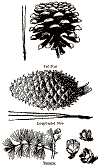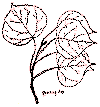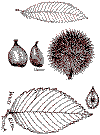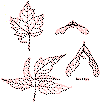by Ernest Thompson Seton
FIFTY COMMON FOREST TREES OF EASTERN NORTH AMERICA
White Pine, or Weymouth Pine
(Pines Strobes)
A noble evergreen tree, up to 175 feet high. The lumberman s prize. Its leaves are in bunches of 5, and are 3 to 5 inches long; cones 4 to 8 inches long. Wood pale, soft, straight-grained, easily split. Warps and checks less than any other of our timbers. A cubic foot weighs 24 lbs. (a cubic foot of water weighs 63 lbs.). Minnesota and Manitoba to Nova Scotia and Pennsylvania.
Red Pine, Canadian Pine, or Norway Pine
(Pines resinosa)
Evergreen; somewhat less than the White Pine, with leaves 4 to 6 inches long, in bunches of 2, comes 1 1/2 to 2 1/2 inches long. Wood darker, harder, and heavier. A cubic foot weighs 30 lbs. Range as above.
Long-Leaned Pine, Georgia Pine, Southern Pine, Yellow
Pine, or Hard Pine
(Pinus Palustris)
A fine tree, up to 100 feet high; evergreen; found in great forests in the Southern States; it supplies much of our lumber now; and most of our turpentine, tar, and rosin. Wood strong and hard, a cubic foot weighs 44 lbs. Its leaves are 10 to 16 inches long, and are in bunches of 3's; cones, 6 to 10 inches long. Range, Virginia to Louisiana and Florida.
Tamarack, Larch, or Hackmatack
(Larix laricina)
A tall, straight tree of the northern swamps yet often found flourishing on dry hillsides. One of the few conifers that shed all their leaves each fall. Leaves 1/2 to 1 inch long; cones 1/2 to 3/4 inch. Wood very resinous, heavy, and hard, "a hard, softwood" very durable as posts. In Manitoba I have seen tamarack fence posts unchanged after twenty years' wear. It is excellent for firewood, and makes good sticks for a rubbing-stick fire. A cubic foot weighs 39 lbs. Found north nearly to the limit of trees; south to northern New Jersey and Minnesota.
White Spruce
(Picea Canadensis)
Evergreen; 60 to 70 or even 150 feet high. Leaves 1/2 to 1/4 inch long; cones 1 1/2 to 2 inches long, are at the tips of the branches and deciduous; the twigs smooth. Wood white, light, soft, weak, straight-grained, not durable; a cubic foot weighs 25 lbs. Its roots afford the wattap or cordage for canoe-building and camp use generally. North to the limit of trees east of Rockies, south to Dakota, Wisconsin, and Maine.
Hemlock
(Tsuga Canadensis)
Evergreen; 60 to 70 feet high; occasionally 100; wood pale, soft, coarse, splintery, not durable. A cubic foot weighs 26 lbs. Bark full of tannin. Leaves 1/2 to 3/4 inch long; cones about the same. Its knots are so hard that they quickly turn the edge of an axe or gap it as a stone might; these are probably the hardest vegetable growth in our woods. Wisconsin to Nova Scotia and south on the mountains to Georgia.
Balsam Tree, or Canada Balsam
(Abies balsamea)
Evergreen; famous for the blisters on its trunk, yielding Canada balsam which makes a woodman's plaster for cuts or a waterproof cement; and for the exquisite odor of its boughs, which also supply the woodman's ideal bed. Its flat leafage is distinctive. Wood pale, weak, soft, perishable. A cubic foot weighs 24 lbs. New Alberta to Newfoundland and south to Virginia.
Bald Cypress
(Taxodium distichum)
A fine forest tree, up to 150 feet, with thin leaves somewhat like those of Hemlock, half an inch to an inch long; cones rounded about an inch through. Sheds its leaves each fall so is "bald" in winter. Noted for the knees or up-bent roots that it develops when growing in water. Timber soft, weak, but durable and valuable; a cubic foot weighs 27 lbs. In low wet country of Mississippi Valley and Southeast coast.
Arbor-vitae, or White Cedar
(Thuya occideutalis)
Evergreen; 50 to 60 feet high. Wood soft; brittle, coarse-grained, extremely durable as posts; fragrant and very light (the lightest on our list). Makes good sticks for rubbing-stick fire. A cubic foot weighs only 20 lbs. The scale-like leaves are about 6 to 8 to the inch, the cones half an inch long or less. Manitoba to Nova Scotia, and Pennsylvania; south on mountains to North Carolina.
Quaking Asp, Quiver Leaf, Aspen Poplar, or Popple
(Populus tremuloides)
A small forest tree, but occasionally 100 feet high. Readily known by its smooth bark, of a light green or whitish color. The wood is pale, soft, close-grained, weak, perishable, and light: A cubic foot weighs 25 lbs. Good only for paper pulp, but burns well when seasoned. When green it is so heavy and soggy that it lasts for days as a fire check or back-log. Leaves 1 1/2 to 2 inches long. Canada and Northern States.
Black Willow
(Salix nigra)
The common Willow of stream-banks, usually 20 to 40 feet high, sometimes 100. Bark nearly black. Its long, narrow, yellow-green shining leaves are sufficiently distinctive. A decoction of Willow bark and roots is said to be the best known substitute for quinine. Noted for early leafing and late shedding; leaves 3 to 6 inches long. Wood pale, weak, soft, close-grained; a cubic foot weighs 28 lbs. Manitoba to Nova Scotia and south to Gulf.
Balsam Poplar, Balm of Gilead, or Tacamahac
(Populus balsamifeya)
Fifty or 60 feet ordinarily, but sometimes 100 feet high. Bark rough and furrowed. The great sine of the buds and their thick shiny coat of fragrant gum are strong marks. Wood much as in the preceding, but weighs 23 lbs. a cubic foot. Leaves 3 to 6 inches long. Canada and Northern States.
Cottonwood
(Populus deltoides)
Small and rare in the Northeast. Abundant and large in West; even 150 feet high. Wood as in other poplars but weighs 24 lbs. a cubic foot. Leaves 3 to 5 inches long. Maine to Georgia and west to Alberta.
Black Walnut
(Juglans nigra)
A magnificent forest tree up to 150 feet high; usually much smaller in the East. Wood a dark purplish brown or gray; hard, close-grained; strong; very durable in weather or ground work, and heavy. A cubic foot weighs 38 lbs. Leaflets 13 to 23; and 3 to 5 inches long. Fruit nearly round, 1 1/2 to 3 inches in diameter. Massachusetts to Minnesota and south to Mississippi.
White Walnut, Oil Nut, or Butternut
(Juglans cinerea)
Much smaller than the last, rarely 100 feet high; with much smoother bark and larger, coarser, compound leaves, of fewer leaflets but the petioles or leaflet stalks, and the new twigs, are covered with sticky down.
The wood is light brown, soft, coarse, not strong but very enduring in weather and ground work; light; leaves 15 to 30 inches long; leaflets 11 to 19 in number and 3 to 5 inches long; fruit oblong, 2 to 3 inches long. Nova Scotia to Minnesota and south to Mississippi.
Pecan
(Hicoria Pecan)
A tall slender forest tree in low moist soil along streams, up to 170 feet in height: famous for its delicious nuts, they are smooth and thin shelled; fruit, oblong, cylindrical, 1 1/2 to 2 1/2 inches long. Its leaves are smooth when mature; leaflets 11 to 15, and 4 to 7 inches long; wood hard and brittle, a cubic foot weighs 45 lbs. Central Mississippi Valley.
Shagbark, Shellbark, or White Hickory
(Hicoria ovata)
A tall forest tree up to 120 feet high. Known at once by the great angular slabs of bark hanging partly detached from its main trunk, forced off by the growth of wood, but too tough to fall. Its leaves are 8 to 14 inches long, with 5 to 7 broad leaflets. The wood is very light in color, close-grained, tough, and elastic. It makes an excellent bow; is the best of fuel. A cubic foot weighs 52 lbs. Dakota to Maine and south to Mississippi.
Mockernut, White Heart, or Big-Bud Hickory
(Hicoria alba)
A tall forest tree, up to 100 feet. Wood much like that of Shagbark, but not quite so heavy (51 lbs.). Its bark is smooth and furrowed like that of the Pignut. Its leaves are like those of the Shagbark, but it has 7 to 9 leaflets, instead of 5 to 7; it has a large terminal bud 1/2 to 3/4 of an inch long, and the leaves have a resinous smell. Its nut in the husk is nearly 2 inches long; the nut shell is 4-ridged toward the point, has a very thick shell, and small, sweet kernel. Maine to Oklahoma and Florida.
Pignut Hickory
(Hicoria glabra)
A tall forest tree; 100 and up to 120 feet high. Wood much as in the Mockernut; bark smooth and furrowed; not loose plates. Leaves 8 to 12 inches long. Nut slightly or not at all angular, very thick shelled; the pear shape of fruit is a strong feature, 11/4 to 2 inches long. Maine to Nebraska and south to the Gulf.
Gray Birch, or Aspen-Leaved Birch
(Betula populifolia)
A small tree found on dry and poor soil; rarely 50 feet high. Wood soft, close-grained, not strong, splits in drying, useless for weather or ground work. A cubic foot weighs 36 lbs. Leaves 2 to 3 inches long. It has a black triangular scar at each armpit. Quebec south to Maryland.
White, Canoe, or Paper Birch
(Betula papyrifera)
A tall forest tree up to 80 feet high; the source of bark for canoes, etc. One of the most important trees in the northern forest. Besides canoes, wigwams, vessels, and paper from its bark, it furnishes syrup from its sap and the inner bark is used as an emergency food. Every novice rediscovers for himself that the outer bark is highly inflammable as well as waterproof, and ideal for fire--lighting. Though so much like the Gray Birch, it is larger, whiter, and with but small black scars at each limb. The timber is much the same, but this weighs 37 lbs. Its leaf and catkin distinguish it; the former is 2 to 3 inches long. All Canada and south to Illinois.
Yellow Birch, or Gray Birch
(Betula lutea)
A forest tree, of 30 to 50 feet in height. Bark obviously birch, but shaggy and gray or dull yellow. Wood as in the others, but reddish. A cubic foot weighs 41 lbs. Leaves 3 to 4 inches long. Minnesota to Newfoundland and south to Virginia.
Ironwood, Hard-Hack, Leverwood, Beetle-Wood, or Hop Hornbeam
(Ostyra Virginiana)
A small tree; 20 to 30, rarely 50, feet high; named for its hardness and its hop-like fruit. Bark furrowed. Wood tough, close-grained, unsplitable. One of the strongest, heaviest, and hardest of timbers. A cubic foot weighs over 51 lbs. That is, it comes near to Shagbark Hickory in weight and perhaps goes beyond it in strength and hardness. Leaves 3 to 5 inches long. Fruit 1 1/2 to 2 1/2 inches long. Dakota, to Nova Scotia and south to Gulf.
Blue Beech, Water Beech, or American Hornbeam
(Carpinus Caroliniana)
A small tree, 10 to 25, rarely 40, feet high; bark smooth. Wood hard, close-grained, very strong; much like Ironwood, but lighter. A cubic foot weighs 45 lbs. Leaves 3 to 4 inches long. United States east of Missouri River.
White Oak
(Quercus alba)
A grand forest tree; over 100 feet up to 150 feet high. The finest and most valuable of our oaks. The one perfect timber for shipbuilders, farmers, and house furnishers. Its wood is pale, strong, tough, fine-grained, durable, and heavy. A cubic foot weighs 46 lbs. I found that when green it weighed 68 lbs. to the cubic foot and of course sank in water like a stone. Called white from pale color of bark and wood. Leaves 5 to 9 inches long. Texas to Minnesota and easterly.
Yellow Oak, Chestnut Oak, or Chinquapin Scrub Oak
(Quercus Muhlenbergii)
A great forest tree; up to 160 feet high; wood as usual, but the heaviest of all when dry; a cubic foot weighs 54 lbs; when green, it is heavier than water, and sinks at once. It is much like the Chestnut Oak but its leaves are narrower, more sharply saw-edged, and its acorns much smaller, about half the size. Its acorns ripen in one season. Leaves 4 to 6 inches long. Louisiana to Iowa and easterly to Massachusetts.
Red Oak
(Quercus rubra)
A fine forest tree, 70 to 80, or even 140, feet high. Wood reddish brown. Sapwood darker. Hard, strong, coarse-grained, heavy. A cubic foot weighs 41 lbs. It checks, warps, and does not stand for weather or ground work. The acorn takes two seasons to ripen. Apparently all those oaks whose nuts take two seasons to ripen have wood that soon rots. The low, flat shape of the cup is distinctive; in fact, it has no cup, it has a saucer; leaves 4 to 8 inches long. Missouri to Minnesota and east to Atlantic.
Scarlet Oak
(Quercus coccinea)
Seventy to 80 or even 100 feet high. Scarlet from its spring and autumn foliage color. The leaves are a little like those of the Black Oak, but are frond-like with three or four deep, nearly even, cuts on each side. The acorns of this can be easily matched among those of the Black Oak, but the kernel of the Scarlet is white, that of the Black is yellow; they take two seasons to ripen. Wood much as in Red Oak but weighs 46 Ibs. per cubic foot. Leaves 4 to 8 inches long. Massachusetts to Georgia and Iowa.
Black Oak, Golden Oak, or Quercitron
(Quercus velutina)
Seventy to 80 or even 150 feet high. The outer bark is very rough, bumpy, and blackish; inner bark yellow. This yields a yellow dye called quercitron. The leaf is of the Scarlet Oak style, but has uneven cuts and usually a large solid area in the outer half. The wood is hard, coarse--grained, checks, and does not stand for weather or ground work. A cubic foot weighs 44 lbs. Wisconsin to Maine and south to Gulf.
Pin Oak, or Swamp Oak
(Quercus palustris)
Fifty to 70 or even 120 feet high, in swampy land. Wood hard, coarse-grained, very strong and tough. Will not stand exposure next to ground. A cubic foot weighs 34 lbs. Its acorns take two seasons to ripen. Leaves 4 to 6 inches long. In moist woods and along swamp edges. Massachusetts to Iowa and Arkansas.
Beech
(Fagus grandifolia)
In all North America there is but one species of Beech. It is a noble forest tree, 70 to 80, and occasionally 120 feet high; readily distinguished by its unfurrowed ashy gray bark. Wood hard, strong, tough, close-grained, pale, heavy. Leaves 3 to 4 inches long. A cubic foot weighs 43 lbs. Wisconsin to Nova Scotia and south to Gulf.
Chestnut
(Castanea dentata)
A noble tree, 60 to 80 or even 100 feet high. A cubic foot of the wood weighs 28 lbs. Leaves 6 to 8 inches long. Massachusetts to Indiana and Mississippi.
White Elm, Water, or Swamp Elm
(Ulmus Americana)
A tall, splendid, forest tree; commonly 100, occasionally 120, feet. Wood reddish brown; hard, strong, tough, very hard to split. A cubic foot weighs 41 lbs. Soon rots near the ground. Leaves 2 to 5 inches long. Manitoba to Nova Scotia and south to Gulf.
Slippery Elm, Moose, or Red Elm
(Ulmus fulva)
Smaller than White Elm, maximum height about 70 feet. Wood dark, reddish, hard, close, tough, strong; durable next the ground; heavy; a cubic foot weighs 43 lbs. Its leaves are larger and rougher than those of the former. Four to 8 inches long, and its buds are hairy, not smooth. Maine to Minnesota and south to Gulf.
Osage Orange, Bodarc (Bois D'arc), or Bow-Wood
(Toxylon pomiferum)
A small tree, rarely 60 feet high. Originally from the middle Mississippi Valley, now widely introduced as a hedge tree. Famous for supplying the best bows in America east of the Rockies. Wood is bright orange; very hard, elastic, enduring and heavy. Leaves 3 to 6 inches long. A cubic foot weighs 48 lbs.
Tulip Tree, White-Wood, Canoe Wood, or Yellow Poplar
(Liriodendron tulipifera)
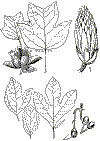
Tulip Tree & Sassafras
One of the noblest forest trees, ordinarily 100 feet, and sometimes 150 feet, high. Noted for its splendid, clean, straight column; readily known by leaf, 3 to 6 inches long, and its tulip-like flower. Wood soft, straight-grained, brittle, yellow, and very light; much used where a broad sheet easily worked is needed but will not stand exposure to the weather; is poor fuel; a dry cubic foot weighs 26 lbs. Mississippi to Atlantic, Lake Ontario to Gulf.
Sassafras, or Ague Tree
(Sassafras sassafras)

Tulip Tree & Sassafras
Usually a small tree of dry sandy soil, but reaching 125 feet high in favorable regions. Its wood is dull orange, soft, weak, coarse, brittle, and light. A cubic foot weighs 31 lbs. Very durable next the ground. Leaves 4 to 7 inches long. Maine to Iowa and Texas to Atlantic.
Sweet Gum, Star-Leaved, or Red Gum, Bilsted, Alligator Tree, or Liquidambar
(Liquidambar styraciflua)
A tall tree up to 150 feet high of low, moist woods, remarkable for the corky ridges on its bark, and the unsplitable nature of its weak, warping, perishable timber. Heart-wood reddish brown, sap white; heavy, weighing 37 lbs. to cubic foot. Leaves 3 to 5 inches long. Massachusetts to Missouri and south to Gulf:
Sycamore, Plane Tree, Buttonball, or Buttonwood
(Platanus occidentalis)

Sycamore, & Red Bud
One of the largest of our trees; up to 140 feet high; commonly hollow. Wood light brownish, weak; hard to split; heavy for its strength. A cubic foot weighs 35 lbs. Little use for weather work. Famous for shedding its bark as well as its leaves. Leaves 4 to 9 inches long. Canada to the Gulf.
Red-bud, or Judas Tree
(Cercis Canadensis)

Sycamore, & Red Bud
Small tree of bottom lands, rarely 50 feet high; so called from its abundant spring crop of tiny rosy blossoms, coming before the leaves, the latter 2 to 6 inches broad. " Judas tree" because it blushed when Judas hanged himself on it (Keeler). Its wood is dark, coarse, and heavy. A cubic foot weighs 40 lbs. Maryland to Iowa and southward.
Sugar Maple, Rock Maple, or Hard Maple
(Acer saccharum)
A large, splendid forest tree, 80 to 120 feet high; red in autumn. Wood hard, strong, tough, and heavy but not durable. A cubic foot weighs 43 lbs. It enjoys with Beech, Hickory, etc., the sad distinction of being a perfect firewood. Thanks to this it has been exterminated in some regions.
Bird's-eye and curled Maple are freaks of the grain. Leaves 3 to 5 inches long. Its sap produces the famous maple sugar. Manitoba to Nova Scotia and south to Gulf.
Silver Maple, White, or Soft Maple
(Aces saccharinum)
Usually a little smaller than the Sugar Maple and much inferior as timber. Wood hard, close-grained. A cubic foot weighs 33 lbs. Leaves 5 to 7 inches long. This tree produces a little sugar. It is noted for its yellow foliage in autumn. Nova Scotia to Minnesota and south to Oklahoma and Georgia.
Red, Scarlet, Water, or Swamp Maple
(Acer rubrum)
A fine tree the same size as the preceding. Noted for its gaming crimson foliage in fall, as well as its red leaf-stalks, flowers, and fruit earlier. Its wood is light-colored, tinged reddish, close-grained, smooth with varieties of grain, as in Sugar Maple; heavy. A cubic foot weighs 39 lbs. Leaves 2 to 6 inches long. Quebec to Minnesota and south to Gulf.
Box Elder, or Ash-Leaved Maple
(Acer Negundo)
A small trees 40 to 50 up to 70 feet high, found chiefly along streams. Wood pale, soft, close-grained, light. A Cubic foot weighs 27 lbs. Poor fuel. Makes paper-pulp. Leaflets 2 to 4 inches long. Massachusetts to British Columbia south to Mexico and Alabama.
Basswood, White-Wood, Whistle-Wood, Lime, or Linden
(Tilia Americana)
A tall forest tree 60 to 125 feet; usually hollow when old. Wood soft, straight-grained, weak, white, very light. A cubic foot weighs 28 lbs. It makes a good dugout canoe or sap trough.
The hollow trunk, split in halves, was often used for roofing. Poor firewood, and soon rots, makes good rubbing-sticks for friction fire. Its inner bark supplies coarse cordage and matting. Its buds are often eaten as emergency food. Leaves 2 to 5 inches wide. Manitoba to Nova Scotia and south to Texas.
Sour Gum, Black Gum, Pepperidge, or Tupelo
(Nyssa sylvatica)
A forest tree up to 110 feet high; in wet lands. Wood pale, very strong, tough, unsplitable, and heavy. A cubic foot weighs 40 lbs. Used for turner work, but soon rots next the ground. Leaves 2 to 5 inches long. Massachusetts to Wisconsin and south to Gulf.
White Ash
(Fraxinus Americana)
A fine forest tree on moist soil; 70 to 90 or even 130 feet high. Wood pale brown, tough, and elastic. Used for handles, springs, bows, also arrows and spears; heavy. A cubic foot weighs 41 lbs. Soon rots next the ground. Called white for the silvery under sides of the leaves; these are 8 to 12 inches long; each leaflet 3 to 5 inches long. Mississippi Valley and east to Atlantic.
Black Ash, Hoop Ash, or Water Ash
(Fraxinus nigra)
A tall forest tree of swampy places; 70, 80, or rarely 100 feet high. Wood dark brown, tough, soft, coarse, heavy. A cubic foot weighs 39 lbs. Soon rots next to the ground. Late in the spring to leaf, and early to shed in the fall. The leaves are is to 16 inches long; its leaflets, except the last, have no stalk, they number 7 to 11, are 2 to 6 inches long. Nova Scotia to Manitoba and south to Virginia.
